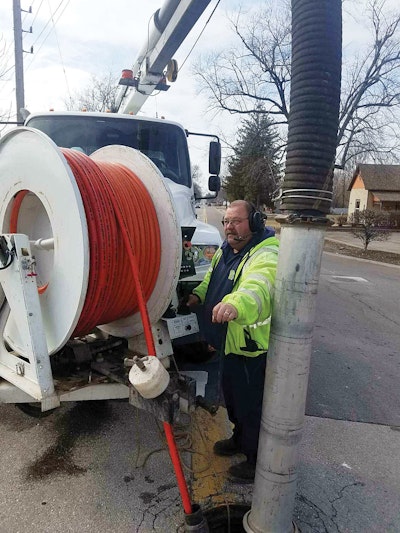
The Camel Maxxx 1200 water-recycling vac truck allows operators to spend more time working and less time leaving the job site to fill up with water, increasing efficiency and productivity.
Interested in Trucks?
Get Trucks articles, news and videos right in your inbox! Sign up now.
Trucks + Get AlertsImagine how much more productive your jet/vac truck could be if you didn’t need to leave the job site a half dozen times a day to refill its water tank. At Commercial Sewer Cleaning, crews don’t need to imagine such a scenario, thanks to a Camel Maxxx 1200 water-recycling vac truck that boosts sewer cleaning productivity 20 to 30 percent, compared to a conventional vac truck.
Under optimal conditions, the Camel — made by Super Products — can operate all day on one 1,500-gallon tank of water, which significantly reduces costs on jobs where the Indianapolis-based company must pay for the water it uses. In some situations, it can even arrive at a job site with an empty water tank and use just the water from a sewer line, says Dennis Young, president of the company, which was established in 1965 by his father, Reford Young.
“If the sewer is relatively clean and the water flow is decent, we can run all day off one initial load of water,” Young says. “That’s significant because I’d say that 75 to 80 percent of the time, we have to pay for water, as well as rent a hydrant meter to track our usage.”
In addition, municipalities in the company’s northern Indiana service area increasingly are telling contractors they can get water only from one specific fire hydrant. That’s because some hydrants and waterlines are so old that municipalities don’t want the hydrants turned on and off repeatedly for fear of rupturing a pipe or overagitating rust and iron inside the pipes, which can turn a neighborhood’s tap water brown, he explains.
“If we’re lucky, a fire hydrant is right where we’re working,” he notes. “Or it might be 250 or 300 feet away, so the farther out we go during cleaning, the farther we have to go back to get water. From a production standpoint, that just kills us.
“And on the sewer cleaning side of our business (the company also does industrial cleaning and sewer inspections), everything is production-based,” he adds. “So the more footage we can clean per day, the better off we are. With the Camel, we might get as much as six or seven hours a day of straight production because we’re not stopping to get more water. We make more money jetting than we do chasing water.”
Less water to treat
Moreover, by recycling the water it uses on cleaning jobs, the Camel also saves municipalities money by not sending more water into sanitary sewers for treatment. “On an average job, we might put 20,000 gallons of waste down a municipality’s sewer,” Young notes.
The Camel also enables crews to operate more safely in high-traffic areas because they aren’t stringing hoses through streets. Young notes one recent sewer cleaning project on U.S. Highway 40, in which the crew never had to break off to get water; that’s a huge safety factor when the truck is situated in the middle of four lanes of traffic.
Built out on a 2018 Freightliner 114SD, the Camel 1200 features a 12-cubic-yard debris tank; 1,500-gallon water tank; Roots blower from Howden(4,500 cfm); water pump with pressure and flow of 2,500 psi/100 gpm; front-mounted control panel; front-mounted hose reel with 270-degree rotation and capacity for 1,000 feet of 1-inch-diameter hose/600 feet of 1 1/2-inch-diameter hose; 26-foot-long boom; and an 8-foot hydraulic extension boom.
In a nutshell, here’s how the wastewater-recycling works: After debris and water enters the waste tank, a device called an ejector plate compacts the solids. As it does so, water passes around its edges to the rear of the tank, leaving the solids behind. From there, the water passes through a filtration screen and then through a centrifugal separator and a Y-strainer with a stainless steel filter. Then it’s fed into the jetting water pump, ready to be used for further cleaning. The filters must be periodically flushed to prevent small grit and debris from damaging the water pump.
A convincing demo
Commercial Sewer Cleaning invested in the vac truck in August 2017 after watching a demo of its capabilities. “It looked like it would make life a lot easier without having to always drag hoses around to fire hydrants, trying to get continuous water,” Young says.
The company also owns five Vactor combination sewer vac trucks with Roots blowers (Howden); a Super Products Camel nonrecycling vac truck; a trailer-mounted water jetter (18 gpm at 4,000 psi) made by Harben (a subsidiary of Flowplant Group); and three liquid-waste vac trucks, two manufactured by Cusco with Hibon (a division of Ingersoll Rand) blowers and one built by Quality Tank with a National Vacuum Equipment blower.
Young says the Camel Maxxx is easy to operate, though it takes a little while longer to learn how to use it, compared to a conventional vac truck. “There’s just a couple more steps you have to do in order to operate it, and you have to clean the filters more often,” he notes. “The filtration screens are self-cleaning, but you still have to do a hard flush with freshwater every so often. But you don’t need to be a mechanical engineer to run it.”
There’s no question the Camel Maxxx costs more than a conventional vacuum truck. But Young expects a good return on the investment. As he puts it, “We’re in the production business, and the better the production, the better the income.”
Moreover, Young estimates that the truck already has recycled more than 900,000 gallons of water. “That’s 900,000 gallons less that we’ve put back into the sewers here in Indiana.”






